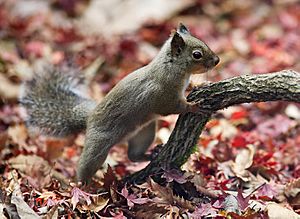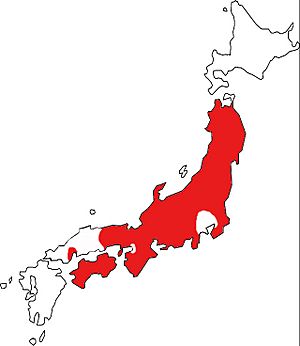Japanese squirrel facts for kids
Quick facts for kids Japanese squirrel |
|
|---|---|
 |
|
| Conservation status | |
| Scientific classification | |
| Genus: |
Sciurus
|
 |
|
| Japanese squirrel's range | |
The Japanese squirrel (Sciurus lis) is a small mammal that lives only in Japan. This means it is endemic to Japan, found nowhere else in the world naturally.
These busy squirrels mostly live on the main island of Honshu. They used to live on Hokkaido island too, but they are now locally extinct there. This means they have disappeared from that specific area.
Japanese squirrels enjoy eating Japanese walnuts. In spring, they mostly eat plants, but not seeds.
Contents
Amazing Behavior
Japanese squirrels are excellent jumpers! They love to leap from one tree to another. Their long, bushy tail helps them steer and balance in the air, like a rudder on a boat.
When climbing down a tree, their two back feet, also called hind legs, can turn almost all the way around (180 degrees). This special ability helps them grip the tree bark and climb down headfirst with ease.
What Japanese Squirrels Eat
Japanese squirrels have a varied diet. Their favorite food is Japanese walnuts. They are very good at cracking open these tough nuts to get to the tasty inside.
During springtime, when seeds might be scarce, they mostly eat other parts of plants. This includes things like buds, leaves, and flowers.
How Japanese Squirrels Reproduce
Japanese squirrels usually have their babies between spring and summer. A mother squirrel can have about two to six babies at a time.
They typically have a new litter of offspring every one to two years. This helps them keep their population healthy.
Who are their Enemies?
Japanese squirrels have several natural enemies in the wild. These include snakes, owls, eagles, and foxes. These predators hunt squirrels for food.
Conservation Status
Long ago, people used to hunt Japanese squirrels. They were hunted for their fur and sometimes for food.
Today, things are different. The Japanese squirrel is now on the red list for Wildlife Protection and Hunting. This means they are a protected species. It is against the law to hunt them, and you cannot keep them as pets. This protection helps ensure these unique squirrels continue to thrive in Japan.
See also
 In Spanish: Ardilla japonesa para niños
In Spanish: Ardilla japonesa para niños


